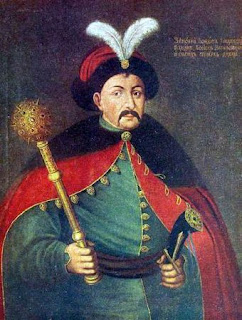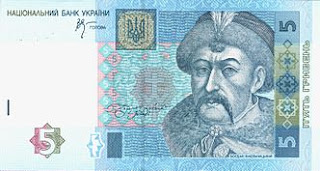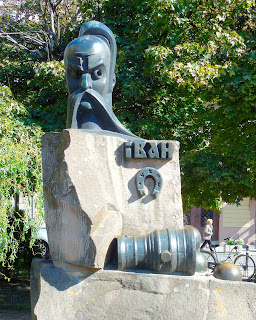A Bargain That Changed History
Have you ever taken time to notice the live-altering effect of decisions you have made? I was thinking about the ripple effect that decision making can have while in Kyiv, Ukraine.
I had just discovered Bohdan Khmelnytskyi.
|

|
|
Khmelnytski: Public Domain. https://en.wikipedia.org/wiki/Khmelnytskyi,_Ukraine
|
|
Visitors to Ukraine can’t miss the many references to the man.
-
There is a city named Khmelnytskyi.
-
Our daughter’s apartment in Kyiv was on Khmelnytskoho Vulitsa (The Street of Khmelytskyi).
-
In front of the oldest church in the city, the church of St. Sophia, stands Khmelnytskyi’s statue.
-
Khmelnytskyi’s face is printed on Ukraine’s national currency.
|

|
|
A 5-hryvnia Note: Public Domain. https://en.wikipedia.org/wiki/Ukrainian_hryvnia
|
Who WAS this man?
It’s no mistake that an enormous statue in his honor stands in front of the church of St. Sophia. Sophia means wisdom; Khmelnytskyi’s statue, therefore, stands at the front door of Wisdom!
|

|
|
Khmelnystskyi's Statue Outside St. Sophia's
|
Why is it placed there?
Obviously, he must have done something important, but to understand what he did, and why he did it, you need to know Ukrainian history during the 1600’s.
At the time, Ukrainians were vassals of Polish gentry, and they resented the domination. A group known as Cossacks grew to lead the opposition against the Polish. You may have seen the unforgetable haircut of the Cossacks - a tuft of hair growing atop an otherwise bald head, as this statue shows.
|

|
|
Statue of a Cossack in Lvov, Ukraine
|
As leader of the Cossacks, Bohdan Khmelnytskyi spearheaded a ruthless campaign against the Poles (and against Ukrainian Jews, whom they saw as Polish allies) and toppled Polish rule. However, the result was not stability; Ukraine was soon in a state of chaos.
Khmelnytskyi needed help. In desperation, he decided to ask the leader of Muscovy (later to become Moscow) for protection. Muscovy was glad to help, and considered its protection to be part of its effort to unite the “Russian lands.”
That decision left a big stamp, a stamp that affects not only Ukraine, but international relations as well.
Three hundred years later:
-
Russia still considers Ukraine to be part of its “protectorate.”
-
Some Ukrainians consider Khmelnytskyi a national hero, others call him a traitor.
-
Jewish people consider his rule as one of their great tragedies.
-
Poles don't trust Ukrainians, and vice versa.
-
The U.S. finds itself opposing Russia's new control of Ukrainian territory.
All that, from one man’s decisions!
As I walked past Khmelnytskyi’s statue, I couldn’t help but think about the stamp left by Khmelnytskyi’s decision, and about the decisions we all have to make. Have you ever thought that something you do today could have repercussions 300 hundred years later?
We all leave our stamp.
Did you know that you can "make your mark" with free art lessons for kids? Find them here!
Have you ever taken time to notice the live-altering effect of decisions you have made? I was thinking about the ripple effect that decision making can have while in Kyiv, Ukraine.
I had just discovered Bohdan Khmelnytskyi.
|

|
|
Khmelnytski: Public Domain. https://en.wikipedia.org/wiki/Khmelnytskyi,_Ukraine
|
|
Visitors to Ukraine can’t miss the many references to the man.
-
There is a city named Khmelnytskyi.
-
Our daughter’s apartment in Kyiv was on Khmelnytskoho Vulitsa (The Street of Khmelytskyi).
-
In front of the oldest church in the city, the church of St. Sophia, stands Khmelnytskyi’s statue.
-
Khmelnytskyi’s face is printed on Ukraine’s national currency.
|

|
|
A 5-hryvnia Note: Public Domain. https://en.wikipedia.org/wiki/Ukrainian_hryvnia
|
Who WAS this man?
It’s no mistake that an enormous statue in his honor stands in front of the church of St. Sophia. Sophia means wisdom; Khmelnytskyi’s statue, therefore, stands at the front door of Wisdom!
|

|
|
Khmelnystskyi's Statue Outside St. Sophia's
|
Why is it placed there?
Obviously, he must have done something important, but to understand what he did, and why he did it, you need to know Ukrainian history during the 1600’s.
At the time, Ukrainians were vassals of Polish gentry, and they resented the domination. A group known as Cossacks grew to lead the opposition against the Polish. You may have seen the unforgetable haircut of the Cossacks - a tuft of hair growing atop an otherwise bald head, as this statue shows.
|

|
|
Statue of a Cossack in Lvov, Ukraine
|
As leader of the Cossacks, Bohdan Khmelnytskyi spearheaded a ruthless campaign against the Poles (and against Ukrainian Jews, whom they saw as Polish allies) and toppled Polish rule. However, the result was not stability; Ukraine was soon in a state of chaos.
Khmelnytskyi needed help. In desperation, he decided to ask the leader of Muscovy (later to become Moscow) for protection. Muscovy was glad to help, and considered its protection to be part of its effort to unite the “Russian lands.”
That decision left a big stamp, a stamp that affects not only Ukraine, but international relations as well.
Three hundred years later:
-
Russia still considers Ukraine to be part of its “protectorate.”
-
Some Ukrainians consider Khmelnytskyi a national hero, others call him a traitor.
-
Jewish people consider his rule as one of their great tragedies.
-
Poles don't trust Ukrainians, and vice versa.
-
The U.S. finds itself opposing Russia's new control of Ukrainian territory.
All that, from one man’s decisions!
As I walked past Khmelnytskyi’s statue, I couldn’t help but think about the stamp left by Khmelnytskyi’s decision, and about the decisions we all have to make. Have you ever thought that something you do today could have repercussions 300 hundred years later?
We all leave our stamp.
Did you know that you can "make your mark" with free art lessons for kids? Find them here!
Have you ever taken time to notice the live-altering effect of decisions you have made? I was thinking about the ripple effect that decision making can have while in Kyiv, Ukraine.
I had just discovered Bohdan Khmelnytskyi.
|

|
|
Khmelnytski: Public Domain. https://en.wikipedia.org/wiki/Khmelnytskyi,_Ukraine
|
|
Visitors to Ukraine can’t miss the many references to the man.
-
There is a city named Khmelnytskyi.
-
Our daughter’s apartment in Kyiv was on Khmelnytskoho Vulitsa (The Street of Khmelytskyi).
-
In front of the oldest church in the city, the church of St. Sophia, stands Khmelnytskyi’s statue.
-
Khmelnytskyi’s face is printed on Ukraine’s national currency.
|

|
|
A 5-hryvnia Note: Public Domain. https://en.wikipedia.org/wiki/Ukrainian_hryvnia
|
Who WAS this man?
It’s no mistake that an enormous statue in his honor stands in front of the church of St. Sophia. Sophia means wisdom; Khmelnytskyi’s statue, therefore, stands at the front door of Wisdom!
|

|
|
Khmelnystskyi's Statue Outside St. Sophia's
|
Why is it placed there?
Obviously, he must have done something important, but to understand what he did, and why he did it, you need to know Ukrainian history during the 1600’s.
At the time, Ukrainians were vassals of Polish gentry, and they resented the domination. A group known as Cossacks grew to lead the opposition against the Polish. You may have seen the unforgetable haircut of the Cossacks - a tuft of hair growing atop an otherwise bald head, as this statue shows.
|

|
|
Statue of a Cossack in Lvov, Ukraine
|
As leader of the Cossacks, Bohdan Khmelnytskyi spearheaded a ruthless campaign against the Poles (and against Ukrainian Jews, whom they saw as Polish allies) and toppled Polish rule. However, the result was not stability; Ukraine was soon in a state of chaos.
Khmelnytskyi needed help. In desperation, he decided to ask the leader of Muscovy (later to become Moscow) for protection. Muscovy was glad to help, and considered its protection to be part of its effort to unite the “Russian lands.”
That decision left a big stamp, a stamp that affects not only Ukraine, but international relations as well.
Three hundred years later:
-
Russia still considers Ukraine to be part of its “protectorate.”
-
Some Ukrainians consider Khmelnytskyi a national hero, others call him a traitor.
-
Jewish people consider his rule as one of their great tragedies.
-
Poles don't trust Ukrainians, and vice versa.
-
The U.S. finds itself opposing Russia's new control of Ukrainian territory.
All that, from one man’s decisions!
As I walked past Khmelnytskyi’s statue, I couldn’t help but think about the stamp left by Khmelnytskyi’s decision, and about the decisions we all have to make. Have you ever thought that something you do today could have repercussions 300 hundred years later?
We all leave our stamp.
Did you know that you can "make your mark" with free art lessons for kids? Find them here!





